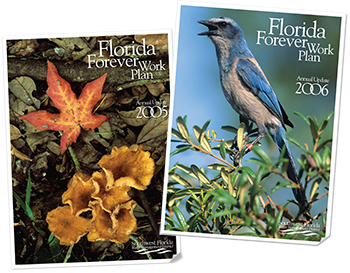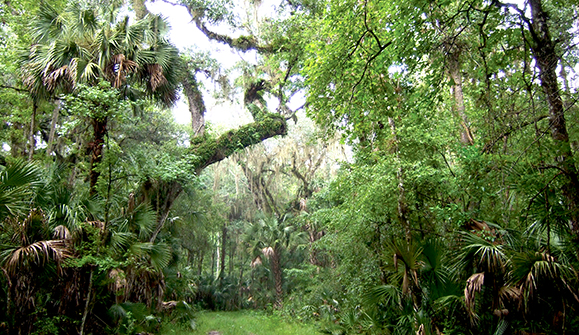Originally purchased as part of the Four River Basins project, the Green Swamp is the headwaters of the Withlacoochee, Ocklawaha, Hillsborough and Peace rivers. Protecting the Green Swamp is vital to protecting the quality and quantity of Florida’s water supply.
Hundreds of thousands of acres of conservation lands have been protected and restored by the District during the past 50 years.
These lands are managed to protect vital water functions and natural systems, which include Florida’s unique plant and wildlife communities. This is done by mimicking the natural fire cycle that historically shaped Florida’s landscape and restoring areas that have been altered by previous activities.
Staff administers prescribed burns, mechanically mows vegetation and oversees seeding and planting activities. These management techniques are important to the survival of most of Florida’s threatened and endangered species. Lands are also managed to provide flood protection and sources of recreation for the public. A number of projects and programs throughout the years have guided the District on the acquisition and management of these important conservation lands.
Four River Basins
The District was created in 1961 to be the local sponsor of the Four River Basins project. This was a major flood control project sponsored by the U.S. Army Corps of Engineers after Hurricane Donna caused massive damage to southwest Florida in 1960. The project, which encompassed a 6,000-square-mile area, included flood control structures and water detention areas.
Through Four River Basins, the District was able to acquire and manage the land necessary for the Tampa Bypass Canal, Lower Hillsborough Flood Detention Area (FDA), Green Swamp FDA, Lake Tarpon Outfall Canal and other projects.
Save Our Rivers
The Save Our Rivers program, or Water Management Lands Trust Fund, of 1981 helped to guide the District’s future land management activities. It stepped away from the flood-control-structure-focused Four River Basins project and allowed the District to acquire lands for the purposes of water management, supply and protection.
District staff began to evaluate potential land purchases for a number of important factors, including the preservation and/or restoration of natural systems, water quality enhancement, recharge potential and potable water supply.
“Around this time, people began to realize that protecting ecosystems makes the most business sense for the taxpayers,” said Eric Sutton, former District Land Resources director. “Ecosystems are the best-engineered systems for water resources and protecting them in their natural state is more cost-effective than investing in massive restoration efforts.”
Preservation 2000
In 1990, the Florida Legislature passed the Preservation 2000 (P2000) Act to broaden the scope of land acquisitions in the state. It allowed the District to purchase lands that would not have been covered under either of the previous two land protection programs. P2000 provided $3 billion over 10 years, of which the District received approximately $225 million.
P2000 allowed the District to acquire and protect significant intact ecosystems that protect water resources, including groundwater, surface waters and other important hydrologic features. An additional benefit of these efforts included the protection of endangered and threatened species habitat and the preservation of archaeological sites.
In total, P2000 helped the District protect more than 150,000 acres of conservation lands.

Florida Forever
The Florida Forever Program was established by the state in 1999 to succeed P2000. Through this program, the District used funds to build and promote water resource and water supply development, restoration, Surface Water Improvement and Management projects, conservation and recreation.
Florida Forever funding allowed the District to acquire and protect more than 55,000 acres of conservation land to help preserve residents’ quality of life.
Looking ahead, the District is focused on continuing to prioritize land protection.
“Given the uncertain economic conditions in Florida, it is difficult to tell exactly what the future holds for conservation land acquisition,” said Sutton. “But we do know that if the people of our state continue to support the protection of lands, when financial conditions improve we will be able to invest in those lands that provide the largest benefit for our water resources.”

